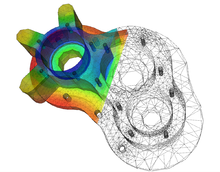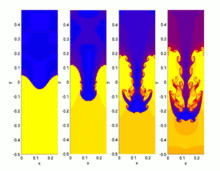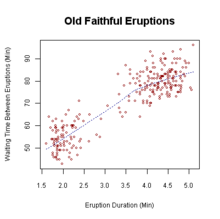(Redirected from Industrial mathematics )
For the Belgian bioinformatics company, see Applied Maths .
Efficient solutions to the vehicle routing problem
require tools from
combinatorial optimization
and integer programming

Applied mathematics is the application of
mathematical methods by different fields such as science, engineering , business,
computer science, and industry . Thus, applied mathematics is a combination of
mathematical science and specialized knowledge. The term "applied mathematics" also describes the
professional specialty in which mathematicians work on practical problems by formulating and studying mathematical models. In the past, practical applications have motivated the development of mathematical theories, which then became the subject of study in pure mathematics where abstract concepts are studied for their own sake. The activity of applied mathematics is thus intimately connected with research in pure mathematics.

A numerical solution to the
heat equation
on a pump casing model using the
finite element method
.
Historically, applied mathematics consisted principally of applied analysis , most notably differential equations ;
approximation theory (broadly construed, to include representations , asymptotic methods, variational methods , and
numerical analysis ); and applied
probability . These areas of mathematics related directly to the development of
Newtonian physics, and in fact, the distinction between mathematicians and physicists was not sharply drawn before the mid-19th century. This history left a pedagogical legacy in the United States: until the early 20th century, subjects such as classical mechanics were often taught in applied mathematics departments at American universities rather than in
physics departments, and fluid mechanics may still be taught in applied mathematics departments. [1] Quantitative finance is now taught in mathematics departments across universities and
mathematical finance is considered a full branch of applied mathematics. [2]
Engineering and computer science departments have traditionally made use of applied mathematics.
Divisions
Edit
Fluid mechanics is often considered a branch of applied mathematics and mechanical engineering.
Today, the term "applied mathematics" is used in a broader sense. It includes the classical areas noted above as well as other areas that have become increasingly important in applications. Even fields such as number theory that are part of pure mathematics are now important in applications (such as
cryptography ), though they are not generally considered to be part of the field of applied mathematics per se. Sometimes, the term "applicable mathematics " is used to distinguish between the traditional applied mathematics that developed alongside physics and the many areas of mathematics that are applicable to real-world problems today.
There is no consensus as to what the various branches of applied mathematics are. Such categorizations are made difficult by the way mathematics and science change over time, and also by the way universities organize departments, courses, and degrees.
Many mathematicians distinguish between "applied mathematics," which is concerned with mathematical methods, and the "applications of mathematics" within science and engineering. A
biologist using a population model and applying known mathematics would not be doing applied mathematics, but rather
using it; however, mathematical biologists have posed problems that have stimulated the growth of pure mathematics. Mathematicians such as
Poincaré and Arnold deny the existence of "applied mathematics" and claim that there are only "applications of mathematics." Similarly, non-mathematicians blend applied mathematics and applications of mathematics. The use and development of mathematics to solve industrial problems is also called "industrial mathematics". [3]
The success of modern numerical mathematical methods and software has led to the emergence of computational mathematics , computational science , and
computational engineering , which use
high-performance computing for the
simulation of phenomena and the solution of problems in the sciences and engineering. These are often considered interdiscipline

Mathematical finance
is concerned with the modelling of financial markets.
Historically, mathematics was most important in the natural sciences and
engineering. However, since World War II, fields outside the physical sciences have spawned the creation of new areas of mathematics, such as game theory and
social choice theory , which grew out of economic considerations.
The advent of the computer has enabled new applications: studying and using the new computer technology itself (computer science) to study problems arising in other areas of science (computational science) as well as the mathematics of computation (for example, theoretical computer science,
computer algebra , numerical analysis ).
Statistics is probably the most widespread mathematical science used in the social sciences , but other areas of mathematics, most notably economics , are proving increasingly useful in these disciplines.
Status in academic departments
Edit
Academic institutions are not consistent in the way they group and label courses, programs, and degrees in applied mathematics. At some schools, there is a single mathematics department, whereas others have separate departments for Applied Mathematics and (Pure) Mathematics. It is very common for Statistics departments to be separated at schools with graduate programs, but many undergraduate-only institutions include statistics under the mathematics department.
Many applied mathematics programs (as opposed to departments) consist of primarily cross-listed courses and jointly appointed faculty in departments representing applications. Some Ph.D. programs in applied mathematics require little or no coursework outside mathematics, while others require substantial coursework in a specific area of application. In some respects this difference reflects the distinction between "application of mathematics" and "applied mathematics".
Some universities in the UK host departments of Applied Mathematics and Theoretical Physics , [4][5][6] but it is now much less common to have separate departments of pure and applied mathematics. A notable exception to this is the Department of Applied Mathematics and Theoretical Physics
at the University of Cambridge , housing the Lucasian Professor of Mathematics whose past holders include Isaac Newton,
Charles Babbage , James Lighthill , Paul Dirac and Stephen Hawking .
Schools with separate applied mathematics departments range from
Brown University, which has a large Division of Applied Mathematics that offers degrees through the doctorate , to
Santa Clara University, which offers only the M.S. in applied mathematics. [7] Research universities dividing their mathematics department into pure and applied sections include MIT . Brigham Young University also has an Applied and Computational Emphasis (ACME), a program that allows student to graduate with a Mathematics degree, with an emphasis in Applied Math. Students in this program also learn another skill (Computer Science, Engineering, Physics, Pure Math, etc.) to supplement their applied math skills.
Associated mathematical sciences
Edit
Applied mathematics has substantial overlap with statistics.
Applied mathematics is closely related to other mathematical sciences.
Scientific computing
Edit
Scientific computing includes applied mathematics (especially numerical analysis), computing science (especially
high-performance computing ), and mathematical modelling in a scientific discipline.
Computer science
Edit
Computer science relies on logic , algebra ,
graph theory, and combinatorics .
Operations research and management science
Edit
Operations research and management science are often taught in faculties of engineering, business, and public policy.
Statistics
Edit
Applied mathematics has substantial overlap with the discipline of statistics.
Statistical theorists study and improve statistical procedures with mathematics, and statistical research often raises mathematical questions. Statistical theory relies on probability and decision theory, and makes extensive use of scientific computing, analysis, and optimization ; for the design of experiments , statisticians use algebra and combinatorial design . Applied mathematicians and statisticians often work in a department of mathematical sciences (particularly at colleges and small universities).
Actuarial science
Actuarial science applies probability, statistics, and economic theory to assess risk in insurance, finance and other industries and professions.

Mathematical economics is the application of mathematical methods to represent theories and analyze problems in economics. The applied methods usually refer to nontrivial mathematical techniques or approaches. Mathematical economics is based on statistics, probability, mathematical programming (as well as other computational methods ), operations research, game theory, and some methods from mathematical analysis. In this regard, it resembles (but is distinct from) financial mathematics , another part of applied mathematics.
According to the Mathematics Subject Classification (MSC), mathematical economics falls into the Applied mathematics/other classification of category 91:
Game theory, economics, social and behavioral sciences
with MSC2010 classifications for ' Game theory' at codes 91Axx and for 'Mathematical economics' at codes
91Bxx .
Applicable mathematics
Edit
Applicable mathematics is a subdiscipline of applied mathematics, although there is no consensus as to a precise definition. [8] Sometimes the term "applicable mathematics" is used to distinguish between the traditional applied mathematics that developed alongside physics and the many areas of mathematics that are applicable to real-world problems today.
Mathematicians often distinguish between "applied mathematics" on the one hand, and the "applications of mathematics" or "applicable mathematics" both within and outside of science and engineering, on the other. [8] Some mathematicians emphasize the term applicable mathematics to separate or delineate the traditional applied areas from new applications arising from fields that were previously seen as pure mathematics. [9] For example, from this viewpoint, an ecologist or geographer using population models and applying known mathematics would not be doing applied, but rather applicable, mathematics. Even fields such as number theory that are part of pure mathematics are now important in applications (such as cryptography ), though they are not generally considered to be part of the field of applied mathematics per se.
Other authors prefer describing applicable mathematics as a union of "new" mathematical applications with the traditional fields of applied mathematics.
[9][10][11] With this outlook, the terms applied mathematics and applicable mathematics are thus interchangeable.

Hi! I am a robot. I just upvoted you! I found similar content that readers might be interested in:
https://en.wikipedia.org/wiki/Applied_mathematics
Is upvoting of post still working in steemit.com
I upvoted a post sometimes it will refund my money, sometimes it will will not refund my money.... at the same time will not reward me at all.
Is upvoting of post still working in steemit.com
I upvoted a post sometimes it will refund my money, sometimes it will will not refund my money.... at the same time will not reward me at all.